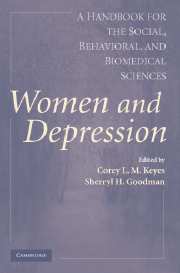Book contents
- Frontmatter
- Contents
- List of Contributors
- Foreword
- Preface
- PART I NOSOLOGY, MEASUREMENT, AND THE EPIDEMIOLOGY OF WOMEN AND DEPRESSION
- PART II BIOLOGICAL, DEVELOPMENTAL, AND AGING MODELS OF RISK
- PART III COGNITIVE, EMOTIONAL, AND INTERPERSONAL MODELS OF RISK
- 7 Cognition and Depression
- 8 Personality and Depression in Women
- 9 The Social Costs of Stress
- 10 Marriage and Depression
- 11 Depression in Women Who Are Mothers
- PART IV SOCIAL, POLITICAL, AND ECONOMIC MODELS OF RISK
- PART V SYSTEMS AND PROCESSES OF TREATMENT, PREVENTION, AND POLICY
- Author Index
- Subject Index
- References
8 - Personality and Depression in Women
Published online by Cambridge University Press: 05 June 2012
- Frontmatter
- Contents
- List of Contributors
- Foreword
- Preface
- PART I NOSOLOGY, MEASUREMENT, AND THE EPIDEMIOLOGY OF WOMEN AND DEPRESSION
- PART II BIOLOGICAL, DEVELOPMENTAL, AND AGING MODELS OF RISK
- PART III COGNITIVE, EMOTIONAL, AND INTERPERSONAL MODELS OF RISK
- 7 Cognition and Depression
- 8 Personality and Depression in Women
- 9 The Social Costs of Stress
- 10 Marriage and Depression
- 11 Depression in Women Who Are Mothers
- PART IV SOCIAL, POLITICAL, AND ECONOMIC MODELS OF RISK
- PART V SYSTEMS AND PROCESSES OF TREATMENT, PREVENTION, AND POLICY
- Author Index
- Subject Index
- References
Summary
Everybody has a personality, or a characteristic manner of thinking, feeling, behaving, and relating to others. Some persons are typically introverted and withdrawn; others are more extraverted and outgoing. Some persons are characteristically agreeable, cooperative, and even altruistic, whereas others might be consistently argumentative, self-centered, and exploitative. The personality traits that distinguish one person from another have been shown to have substantial temporal stability, heritability, cross-situational consistency, and functional relevance to a wide variety of important life outcomes, including (but not limited to) career success, well-being, marital stability, and physical health (Pervin & John, 1999).
Personality traits are important to consider when attempting to explain gender differences in depression for two fundamental reasons. First, there is a considerable amount of research indicating that some personality traits do provide a vulnerability to the occurrence of mood disorders, and, second, these personality traits have been shown to obtain consistent gender differences.
DEPENDENCY, DEPRESSION, AND WOMEN
One of the more heavily researched personality dispositions for the development of depressive episodes is the personality trait of dependency (Clark, Watson, & Mineka, 1994). Dependency has been studied extensively within general personality research, assessed typically by the Depressive Experience Questionnaire (Blatt & Zuroff, 1992; Santor, Zuroff, & Fielding, 1997), the Sociotropy-Autonomy Scale (SAS; Robins, Hayes, Block, Kramer, & Villena, 1995), the Personality Style Inventory (Robins et al., 1995), or the Interpersonal Dependency Inventory (IDI; Hirschfield et al., 1977).
- Type
- Chapter
- Information
- Women and DepressionA Handbook for the Social, Behavioral, and Biomedical Sciences, pp. 176 - 198Publisher: Cambridge University PressPrint publication year: 2006
References
- 2
- Cited by



